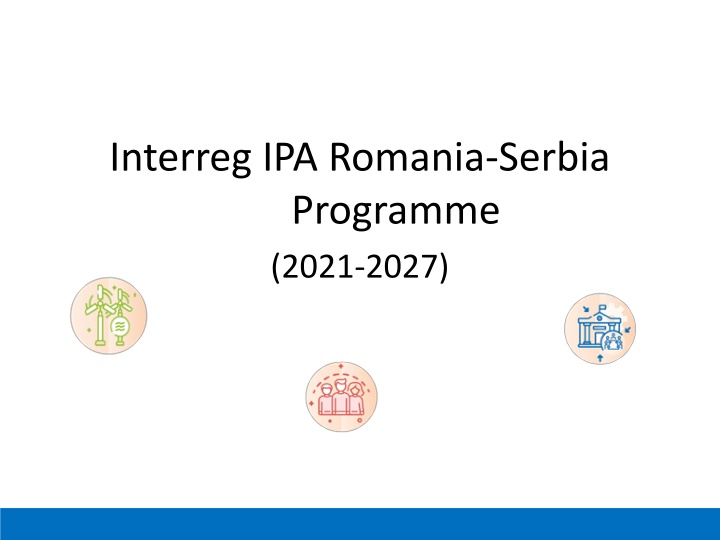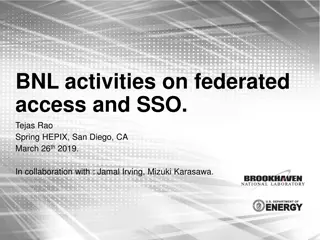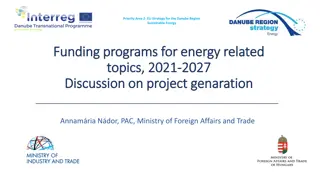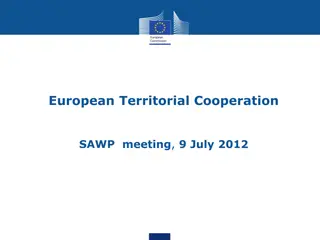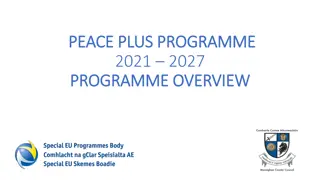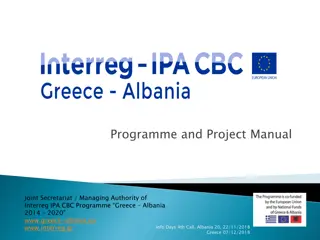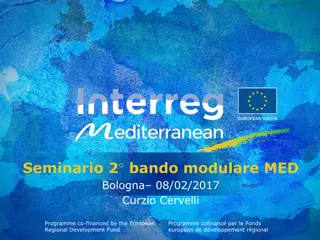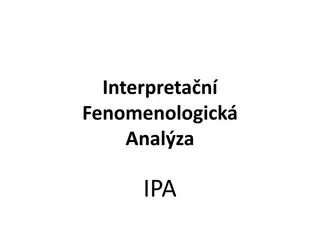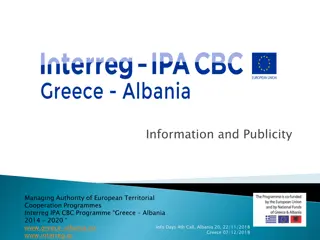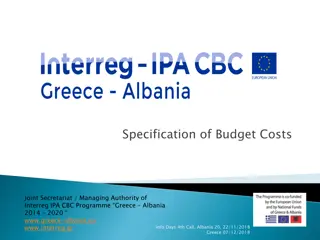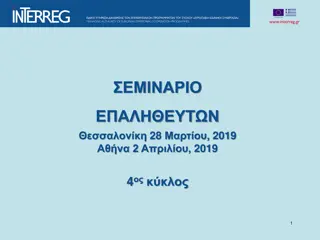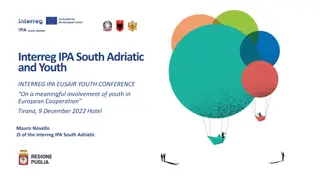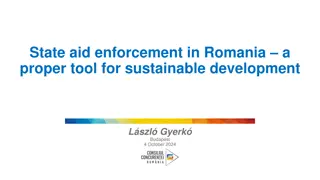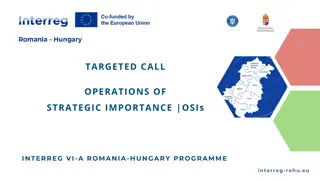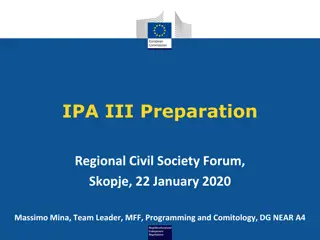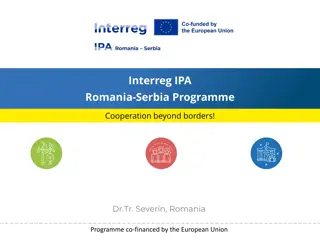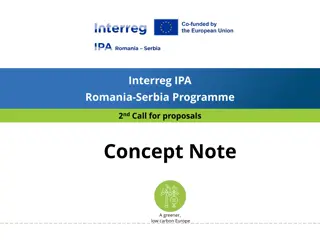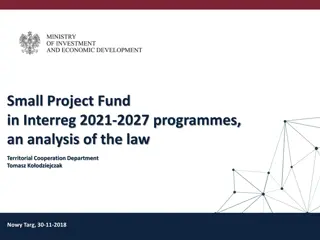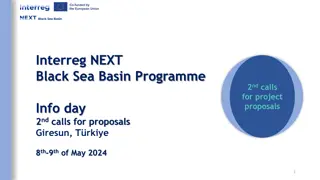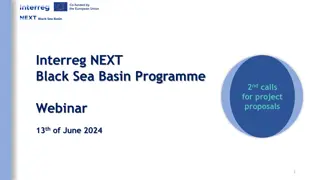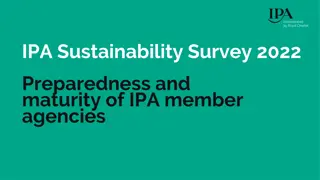Interreg IPA Romania-Serbia Programme 2021-2027: Enhancing Cooperation for Sustainable Development
This programme focuses on enhancing protection of nature, promoting renewable energy, improving access to education and healthcare, and supporting climate change adaptation. By fostering cross-border cooperation, it aims to address joint challenges and promote sustainable development in the Romania-Serbia region through various projects.
Download Presentation

Please find below an Image/Link to download the presentation.
The content on the website is provided AS IS for your information and personal use only. It may not be sold, licensed, or shared on other websites without obtaining consent from the author.If you encounter any issues during the download, it is possible that the publisher has removed the file from their server.
You are allowed to download the files provided on this website for personal or commercial use, subject to the condition that they are used lawfully. All files are the property of their respective owners.
The content on the website is provided AS IS for your information and personal use only. It may not be sold, licensed, or shared on other websites without obtaining consent from the author.
E N D
Presentation Transcript
Interreg IPA Romania-Serbia Programme (2021-2027)
The Programme SO 1: enhancing protection and preservation of nature, biodiversity, and green infrastructure, including in urban areas, and reducing all forms of pollution (2.7); SO 1: improving equal access to inclusive and quality services in education, training and lifelong learning through developing accessible infrastructure, including by fostering resilience for distance and on-line education and training (4.2); SO: enhance the institutional capacity of public authorities, in particular those mandated to manage a specific territory, and of stakeholders (ISO 1.1) SO 2: promoting renewable energy in accordance with Directive (EU) 2018/2001, including the sustainability criteria set out therein (2.2); SO 2: ensuring equal access to health care and fostering resilience of health systems, including primary care, and promoting the transition from institutional to family-based and community-based care (4.5); SO 3: promoting energy efficiency and reducing greenhouse gas emissions (2.1); P3: Increasing border management capacity SO 4: promoting climate change adaptation and disaster risk prevention and resilience, taking into account eco- system based approaches (2.4); SO 3: enhancing the role of culture and sustainable tourism in economic development, social inclusion and social innovation (4.6); P1: Environmental protection and risk management Total IPA budget: 74.566.827 euro P2: Social and economic development
Programme structures Decision making: Implementation and control: Managing authority National authority Monitoring Committee Joint Secretariat (Timi oara) Joint Secretariat Antenna Advisory: (Zrenjanin) Audit authority European Commission
Interreg projects: - Tackle joint problems/challenges and the importance of cross-border cooperation for the topic addressed is clearly demonstrated; There is a clear benefit from cooperating for the project partners / target groups / project area / programme area; For all operations, it is compulsory that the partner has among its attributions, according with its statute or according to the national legislation, the implementation of the proposed activities or that the partner has an agreement with the institutions able to implement such activities, according with its statute or according to the national legislation; The project activities have cross-border impact on the Programme area, contribute to the objectives of the Programme and the results cannot be achieved without cross-border cooperation; Are prepared and implemented jointly (minimum 2 partners maximum 5 partners) across border and all partners play a defined role in the partnership; Each project has one Lead partner; All partners accomplishing the following cooperation criteria: - - - - - -
Cooperation criteria Joint development (mandatory) means that the project must be designed in common by partners from both sides of the border. This means that project proposals must clearly integrate the ideas, priorities and actions of stakeholders on both sides of the border. The Lead Partner is the coordinator of this process but should include other partners from the beginning of the development process. The project must show the importance of cooperation in the specific field; Joint implementation (mandatory) means that activities must be carried out and coordinated among partners on both sides of the border. It is not enough that activities run in parallel. There must be clear content-based links between what is happening on either side of the border and regular contact between the two sides. The Lead Partner is responsible for ensuring that activities are properly coordinated, that schedules are kept and that the right quality levels are achieved. The project must demonstrate that the results cannot be achieved without cooperation and that there is a clear benefit for the programme area steaming from the project partners cooperation; Joint financing (mandatory) means that there will be only one contract per project and there must therefore be one joint project budget. The budget should be divided between partners according to the activities carried out. There is also only one project bank account for the EU contribution (held by the Lead Partner) and payments representing EU support are made from the programme to this account. The Lead Partner is responsible for administration and distribution of these funds and for reporting on their use. Funding should come from both sides of the border and illustrates the commitment by each partner to the joint project. The distribution of financial resources should reflect tasks and responsibilities of the partners. Joint staffing (optional) means that the project should not duplicate functions on either side of the border. Therefore, regardless of where the person is located, there should be one joint project manager, one joint financial manager etc., (of course more staff may be required for larger projects). The staff will be responsible for project activities on both sides of the border.
The Lead Partner Main responsibilities: assume responsibility for ensuring the implementation of the entire project; ensure that expenditure presented by all partners has been incurred in implementing the project and corresponds to the activities agreed between all the project partners; make sure and satisfy itself that all partners make all expenditure according to the programme relevant public procurement rules; present and ensure that the partners submit their expenditures to the controllers; ensure that all partners submit their contributions to the project report; observe and make sure that all partners respect the provisions from the Visual Identity Manual; submit project reports to the JS via the JEMS; transfers to the partners the IPA funds received from the MA.
Project partners and project ideas If you look for project ideas, please consult the projects implemented during the previous 2 programming periods: https://romania-serbia.net/2021- 2027/capitalization/capitalization-2007-2013/ https://romania-serbia.net/2021- 2027/capitalization/capitalization-2014-2020/ Here you can also find the contact details from project partners, if you are in search of a project partner. ! These links can also be helpful for capitalization (next slide)
Capitalization Project partners should capitalise on results previously achieved, as during the technical and financial evaluation it is assessed that the project makes use of available knowledge and builds on existing results and practices (2 points) In this sense, projects partners may use the results: a) achieved with the same partnership or other partnership in the Interreg IPA CBC Romania-Serbia in the 2007-2013 & 2014-2020 period; b) achieved with other funds, programmes, initiatives, projects they participated in; c) achieved by the organisation and recognised as a good practice. Project partners must explain in the AF what is the additional added value of transferring/ using these results.
Financial aspects A project`s eligible budget is made up of: 85% IPA funds + 13 % national co-financing+ 2% own contribution(for RO partners) or 85% IPA funds + 15% own contribution (for RS partners) Pre-financing: 15% of the IPA funds; SCOs (lump sum for project preparation and project closure, flat rate for staff costs, office & administration and travel and accommodation);
What is the intervention logic*? The causal link between the territorial need or challenge that needs to be tackled, and the envisaged activities, outputs and desired results, meaning the expected change. *for more details, please consult the Guide for Indicators, Annex 1 to the Applicant`s Guide (https://romania-serbia.net/2021-2027/wp- content/uploads/2022/10/Annex-A-Guide-for-indicators.pdf )
Programme intervention logic Territorial needs Programme specific objectives Types of actions Output indicators Result Indicators
Project intervention logic Project specific objective Work package Activities Output/s Result/s
Project vs.Programme Project Interreg Programme The need and the challenge addressed by the project The territorial need and the challenge identified by the Programme Project specific objective Programme specific objective under which the project is submitted Work package Change Types of actions identified within the SO under which the project is submitted Project activities Output indicators set for the SO under which the project is submitted Project deliverables and outputs Results indicators set for the SO under which the project is submitted Project results
Let`s start SO WP Results Investments Activities Outputs Step 1 Create a Work package (WP) this is the building block of the project.
Step 2 SO WP Results Investments Activities Outputs Define a specific objective that will be achieved when all activities in the work package are implemented and outputs delivered. Describe the communication objective and target audience.
Step 3 SO WP Results Investments Activities Outputs List the investments* that will be delivered within the work package. Investments should be grouped by their specificity. All equipment purchased for one output/ activity = one investment. Add elements related to: justification, relevance, target group, location, ownership. risks, documentation, * max.20 investments/project
Step 4 SO WP Results Investments Activities Outputs Describe the activities (max.20/project) by which the project achieves the SO and related communication objective. Project partner`s involvement in each activity should also be described. Add deliverable/s for each activity (max. 20/activity), which are: side-products or services that contribute to the achievement/development of a project output; the quantified outcomes of an activity.
Step 5 SO WP Results Investments Activities Outputs Describe the outputs (max.10/project) that will be delivered during the implementation. Outputs are: the main achievement of a set of project activities; different from deliverables; correlated with programme output indicators and share their measurement unit; More than one project output can contribute to the same programme output indicator.
Step 6 SO WP Results Investments Activities Outputs Select the programme result indicators you will contribute to (what do you expect to change following the activities you plan to implement and the outputs you plan to deliver) and describe the project result/s (max. 20/project): All project results will be aggregated at the level of the corresponding result indicator/s you select; You must select only result indicators which are linked with the selected output indicators.
Managing Authority for Interreg IPA Romania Serbia Programme
